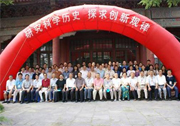| 中文题目: | 守圉增壮——明末西洋筑城术之引进 | ||||||
| 英文题目: | The Trace Italienne in China: Introduction of European Fortification in the Late Ming | ||||||
| 作 者: | 郑 诚 | ||||||
| 刊物名称: | 自然科学史研究 | ||||||
| 发表年度: | 2011 | ||||||
| 卷: | |||||||
| 期: | 2 | ||||||
| 页码: | 129-150 | ||||||
| 中文摘要: | 明朝末年,为对抗后金与流寇,徐光启等具有天主教背景的士大夫,在积极引进西洋火砲的同时,大力提倡采用西洋筑城术,建造新型防御工事。本文考察了徐光启、孙元化、韩云韩霖兄弟推动西法筑城的艰难历程;探讨了韩氏兄弟编译西洋筑城法的来源与影响;揭示了马维城建造西洋锐角台始末;最后,对明清时期何以未能成功引进欧洲筑城术,略申己见。 |
||||||
| 英文摘要: | In the late Ming Dynasty, Xu Guangqi and other Catholic literati were actively involved with military affairs because of the invasion of Manchu and the threat of roving bandits. They imported cannons and gunners from Macau, and also worked hard to introduce European fortification, i.e., the trace Italienne. This paper has six parts. The first and second one illustrates how Xu and his student Sun Yuanhua, made their sustained efforts in building bastions. Then, based on the translation “Western Fortress” by Han Yun and Han Lin brothers (also Xu’s students), the Italian source and the transition of certain technology are explored. Part 4 focuses on Ma Weicheng, who allegedly directed the building of 32 bastions between the year of 1638 and 1643. Part 5 surveys the spread of the knowledge of trace Italienne in Qing dynasty. The final part discusses the reasons why the art of European fortification ended prematurely in early modern China. |
||||||





